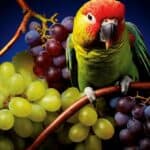As a kakariki owner, you may wonder if it’s safe for your feathered friend to consume fruit. While fruit can be a nutritious addition to your pet’s diet, it’s essential to understand which fruits are safe and how much to give them.
In this article, we will explore the benefits and potential risks of feeding fruit to kakarikis. We will discuss the safe fruits for these birds and how to introduce them to your pet’s diet gradually. Let’s dive in and learn more about feeding fruit to your kakariki.
Can Kakarikis eat fruit? Yes, Kakarikis can indeed eat fruit as part of their diet. These delightful parakeets enjoy a varied menu, and including fruits like apples, berries, grapes, and oranges can be beneficial for their health. However, it’s crucial to offer fruits in moderation and ensure they are fresh and free from any harmful pesticides. While fruits provide essential vitamins, minerals, and antioxidants, they should be accompanied by a balanced diet, including pellets, seeds, and vegetables. Always prioritize the well-being of your Kakariki and consult with an avian veterinarian to establish the ideal dietary plan for these vibrant and energetic birds.
Key Takeaways
- Kakarikis are omnivorous and require a balanced diet of plant- and animal-based foods.
- Fruit is a good source of vitamins, minerals, and antioxidants for kakarikis.
- Not all fruits are safe for kakarikis to consume, and it’s essential to introduce new foods gradually to avoid upsetting their digestive system.
- Balancing your kakariki’s diet is crucial for their overall health and well-being.
Understanding the Kakariki Diet
Before exploring whether kakarikis can consume fruit, it is essential to understand their dietary requirements. These birds are omnivorous, which means their diet should consist of both plant-based and animal-based foods. In the wild, kakarikis feed on a wide range of seeds, nuts, insects, and fruits.
Kakarikis require a balanced diet to stay healthy. Their diet should include a variety of different foods to ensure they get all the necessary vitamins and minerals. Providing a balanced diet will improve your pet bird’s overall well-being and keep them in top condition.
The Nutritional Benefits of Fruit for Kakarikis
Feeding your pet kakariki a variety of fruits can bring several nutritional benefits to their diet. Fruits are a great source of essential vitamins and minerals that support your bird’s overall health and wellbeing.
Vitamin C: Fruits like kiwi, mango, and strawberry are rich in vitamin C, which is essential for the growth and repair of tissues in your kakariki’s body. It also helps boost their immune system to ward off diseases and infections.
| Fruit | Nutritional Benefits |
|---|---|
| Kiwi | High in vitamin C, vitamin K, and dietary fiber. |
| Papaya | Rich in vitamin A, vitamin C, and potassium. |
| Mango | Excellent source of vitamin C, vitamin A, and dietary fiber. |
| Strawberry | High in vitamin C, manganese, and dietary fiber. |
Dietary Fibre: Fruits like apple, pear, and grapes are great sources of dietary fiber, which helps regulate your kakariki’s digestive system and prevent constipation.
Antioxidants: Fruits like blueberry, raspberry, and blackberry are rich in antioxidants, which help protect your pet bird’s cells from damage caused by free radicals.
Note: Always wash fruits thoroughly before feeding them to your kakariki to remove any pesticides or harmful chemicals.
Include a variety of fruits in your kakariki’s diet to ensure they get all the necessary nutrients. However, keep in mind that fruits should not be the only food source for your pet bird. It is essential to balance their diet with other food sources, such as seeds, nuts, and insects, to ensure they receive all the necessary nutrients to stay healthy.
Safe Fruits for Kakarikis
Feeding your kakariki with the right fruits is essential to keep them healthy and happy. However, not all fruits are safe for your pet bird to consume. Some fruits may contain toxins that can harm your feathered friend. Here are some safe fruit options that you can consider adding to your pet kakariki’s diet:
| Fruit | Description |
|---|---|
| Apples | Remove the seeds and core and serve in small pieces. Apples are rich in vitamins A and C, potassium, and fibre. |
| Berries | Strawberries, raspberries, blueberries, and blackberries are all safe for kakarikis. They are a good source of antioxidants, vitamins, and minerals. |
| Mango | Remove the skin and seed and serve in small pieces. Mangoes are rich in vitamins A and C, potassium, and fibre. |
| Papaya | Remove the skin and seeds and serve in small pieces. Papayas are an excellent source of vitamin C and contain enzymes that aid digestion. |
| Pears | Remove the seeds and core and serve in small pieces. Pears are rich in vitamins C and K, copper, and fibre. |
Remember to always wash the fruits thoroughly before serving them to your kakariki. Additionally, introducing a new fruit to your bird’s diet should be done gradually to avoid digestive issues.
Note: Avoid feeding your kakariki with avocados as they may be toxic or harmful to these birds.
Best Fruit Options for Kakarikis
Kakarikis can eat a variety of fruits, but some options are better suited for their dietary needs than others. Here are some of the best fruit choices for your pet kakariki:
| Fruit | Nutritional Benefits | Preparation Tips |
|---|---|---|
| Apple | High in fiber, vitamin C, and antioxidants | Slice into small pieces and remove seeds |
| Banana | Good source of vitamin B6 and potassium | Peel and slice into small pieces |
| Mango | Rich in vitamin A and fiber | Remove skin and pit and slice into small pieces |
| Papaya | Contains enzymes that aid in digestion | Remove skin and seeds, and slice into small pieces |
| Strawberries | High in vitamin C and antioxidants | Remove the stem and slice into small pieces |
Note: These fruits should be offered in moderation, and always be washed thoroughly before serving. It’s also important to remove any seeds, pits, or stems that can be a choking hazard for your pet.
Introducing Fruit to Your Kakariki’s Diet
If you’re planning to introduce fruit to your kakariki’s diet, it’s important to do so gradually. Sudden changes to their diet can upset their digestive system and cause health problems. Start by offering small amounts of fruit and gradually increase the quantity over time.
When offering fruit, make sure it is ripe and fresh. Avoid feeding your kakariki fruits that are overripe, mouldy, or spoiled as these can be harmful to your pet’s health.
It’s also important to vary the type of fruit you offer your kakariki. This will provide a wider range of nutrients and prevent boredom. However, always ensure that the fruits you offer are safe for your pet to consume.
If your kakariki is hesitant to try new fruits, you can try slicing them into smaller pieces or mixing them in with their regular food to encourage them to try it.
Always provide your kakariki with fresh water and closely monitor their behaviour and health when introducing new foods to their diet.
Potential Risks and Precautions
While fruit can be a healthy addition to your kakariki’s diet, some risks should be considered. Here are some precautions to take when feeding fruit to your pet:
- Introduce fruit gradually, starting with small portions to avoid upsetting your bird’s digestive system.
- Be sure to wash all fruit thoroughly before serving to remove any harmful pesticides or chemicals.
- Avoid giving your kakariki too much fruit, as it can lead to obesity and other health issues.
- Never give your bird avocado, as it is toxic to them and can cause serious health problems.
- Avoid giving your kakariki fruit pits or seeds, as they can pose a choking hazard.
By following these precautions, you can safely incorporate fruit into your kakariki’s diet and provide them with the nutrients they need to thrive.
Balancing Your Kakariki’s Diet
While fruit can be a healthy addition to your kakariki’s diet, it’s important to ensure they are receiving a balanced variety of nutrients. In addition to fruit, your pet should be offered a mix of seeds, nuts, and animal-based protein sources like insects or cooked eggs.
When introducing new foods to your kakariki, monitor their reaction and adjust the quantities as necessary. Too much fruit, for example, can lead to obesity or digestive issues. Aim to offer a variety of foods in moderation to ensure your pet’s nutritional needs are being met.
Consult with a veterinarian or avian specialist for guidance on creating a well-rounded diet plan for your kakariki, especially if they have any specific dietary requirements or health concerns.
Conclusion
In conclusion, feeding your pet kakariki fruit can offer several nutritional benefits, provided it’s done in moderation and with caution. Fruit can provide them with essential vitamins and minerals while giving them a tasty treat. However, not all fruits are suitable for kakarikis, and some can even be harmful to their health. When introducing fruits to your kakariki’s diet, make sure to start gradually and monitor their reactions.
Remember, a balanced diet is crucial for the overall health of your kakariki. In addition to fruits, they require a variety of plant-based and animal-based foods to meet their dietary needs. By offering a balanced and varied diet, you can ensure that your feathered friend’s health and happiness remain optimal.
FAQ
Q: Can kakarikis eat fruit?
A: Yes, kakarikis can safely consume fruit as part of their diet. Fruit offers several nutritional benefits and can be a source of vitamins, minerals, and antioxidants that support their overall health and well-being.
Q: What is the kakariki diet?
A: Kakarikis are omnivorous birds that require a balanced diet of plant- and animal-based foods. Their diet typically includes a variety of seeds, nuts, insects, and fruits.
Q: What are the nutritional benefits of fruit for kakarikis?
A: Fruit is a good source of vitamins, minerals, and antioxidants that can support the overall health of kakarikis. The natural sugars found in fruit also provide a quick source of energy for these active birds.
Q: What fruits are safe for kakarikis?
A: Some safe fruits for kakarikis include apples, bananas, berries, melons, and pears. These fruits are not only safe but also nutritious for your feathered friend.
Q: What are the best fruit options for kakarikis?
A: Kakarikis can eat a variety of fruits, but some options are more suitable for their dietary needs. Some of the best fruit choices for kakarikis include apples, grapes, blueberries, and strawberries.
Q: How should I introduce fruit to my kakariki’s diet?
A: It is important to gradually introduce fruit to your kakariki’s diet to avoid upsetting their digestive system. Start by offering small amounts of fruit and gradually increase the portion size over time.
Q: Are there any potential risks when feeding fruit to kakarikis?
A: While fruits can be beneficial for kakarikis, there are some risks to be aware of. It is important to practice moderation and avoid certain fruits that may be toxic or harmful to these birds.
Q: How can I balance my kakariki’s diet?
A: Balancing your kakariki’s diet is crucial for their overall health. Fruits should be offered in moderation and balanced with other food sources to ensure your pet receives all the necessary nutrients.



Have comments or questions about this article? Then get involved!
Spotted an error or something we have missed? Let us know